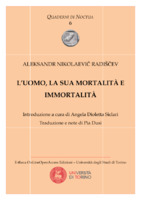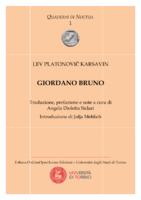Sfoglia documenti (2 in totale)
Sort by:
L’uomo, la sua mortalità e immortalità
Il volume comprende un ampio saggio introduttivo e la traduzione italiana del trattato Sull’uomo, sulla sua mortalità o immortalità di Aleksandr Nikolaevič Radiščev, scritto in Siberia tra il 1792 e il 1796, pubblicato diversi anni dopo la morte dell’autore. Il trattato inizia con l’esplorazione dei percorsi e dei risultati delle diverse scienze che offrono una conoscenza dei vari aspetti del mondo umano, ma non penetrano la sua essenza. A fondamento del molteplice e del mutevole resta, sconosciuta e indefinibile, la sostanza unica. Dietro il Leibniz dell’epigrafe, dietro Herder e Mendelssohn, si affaccia, non detto, il pericoloso, e forse più amato, Spinoza. Radiščev è una figura emblematica del Settecento Russo, considerato il teorico dell’uguaglianza, e da alcuni critici, a torto, un precursore della rivoluzione russa. Il pensiero di Radiščev a questo proposito è chiaro e matura attraverso le letture del Beccaria, del Filangieri e del Dragonetti: l’uguaglianza di natura (giusnaturalismo) è utopica se non diventa uguaglianza di fronte alla legge.
The volume includes an extensive introductory essay and an Italian translation of the treatise On Man, His Mortality or Immortality by Aleksandr Nikolaevič Radiščev, written in Siberia between 1792 and 1796, published several years after the author’s death. The treatise begins with an exploration of the paths and achievements of the different sciences that offer knowledge of the various aspects of the human world, but do not penetrate its essence. At the foundation of the manifold and the changeable, there remains, unknown and indefinable, the unitary substance. Behind the Leibniz of the epigraph, behind Herder and Mendelssohn, there appears, unspoken, the dangerous, and perhaps most beloved, Spinoza. Radiščev is an emblematic figure of 18th-century Russia, considered the theorist of equality and by some critics, wrongly, a precursor of the Russian Revolution. Radiščev’s thought in this regard is clear and matures through the readings of Beccaria, Filangieri and Dragonetti: equality of nature (natural law) is utopian if it does not become equality before the law.
The volume includes an extensive introductory essay and an Italian translation of the treatise On Man, His Mortality or Immortality by Aleksandr Nikolaevič Radiščev, written in Siberia between 1792 and 1796, published several years after the author’s death. The treatise begins with an exploration of the paths and achievements of the different sciences that offer knowledge of the various aspects of the human world, but do not penetrate its essence. At the foundation of the manifold and the changeable, there remains, unknown and indefinable, the unitary substance. Behind the Leibniz of the epigraph, behind Herder and Mendelssohn, there appears, unspoken, the dangerous, and perhaps most beloved, Spinoza. Radiščev is an emblematic figure of 18th-century Russia, considered the theorist of equality and by some critics, wrongly, a precursor of the Russian Revolution. Radiščev’s thought in this regard is clear and matures through the readings of Beccaria, Filangieri and Dragonetti: equality of nature (natural law) is utopian if it does not become equality before the law.
Giordano Bruno
Il volume comprende la traduzione italiana del Giordano Bruno di Lev Platonovič Karsavin, una prefazione della traduttrice e una introduzione di Julja Mehlich, studiosa di Karsavin. Il testo tradotto fu pubblicato a Berlino nel 1923 e a lungo ignorato dalle ampie bibliografie su Bruno e su Karsavin. Il valore di Bruno, secondo Karsavin, starebbe nel sentimento e nella chiara coscienza della sua unità di spirito con l’Universo divino e con Dio stesso. «L’anima della filosofia del Nolano» è «l’eroico furore», fondamento teorico e pratico dell’unità di vita e di pensiero. Ma in questo Karsavin coglie anche il limite di Bruno: ossia il non aver saputo tener fede all’intuizione secondo la quale l’Assoluto non si identifica mai con la totalità, sia pure infinita, del relativo. L’infinità del Divino è, infatti essenzialmente diversa dall’infinità dell’empirico. In questa confusione Bruno sarebbe l’emblema di tutta l’epoca rinascimentale. Nella sua Introduzione la Mehlich evidenzia nella trattazione di Karsavin il ricorso a un duplice metodo, quello formale dell’individualizzazione, di Heinrich Rickert, e quello fondato sul principio del vseedinstvo (unitotalità), risalente al pensiero di Vladimir Sergeevič Solov’ëv, e ampiamente utilizzato nel pensiero filosofico-religioso russo del Novecento. Peculiarità dell’approccio di Karsavin sarebbe, secondo la studiosa, l’unione dei due piani con la concezione dell’essere storico come personale, e dello sviluppo della storia come storia della persona, della narrazione del suo destino.
The volume includes the Italian translation of Giordano Bruno by Lev Platonovič Karsavin, a preface by the translator and an introduction by Julya Mehlich, a scholar of Karsavin. The translated text was published in Berlin in 1923 and long ignored by the extensive bibliographies on Bruno and Karsavin. Bruno’s value, according to Karsavin, lies in the sentiment and in the clear awareness of his own unity of spirit with the divine Universe and with God himself. “The soul of Nolan’s philosophy” is “heroic fury,” the theoretical and practical foundation of unity of life and thought. But in this Karsavin also grasps Bruno’s limitation: that is, the failure to be able to be faithful to the intuition that the Absolute is never identified with the totality, even if infinite, of the relative. The infinity of the Divine is, in fact, essentially different from the infinity of the empirical. In this confusion, Bruno would be the emblem of the entire Renaissance era. In her Introduction, Mehlich highlights the use of a double method in Karsavin’s treatment: the formal one of individualization, by Heinrich Rickert, and the one based on the principle of vseedinstvo (unitotality), dating back to the thinking of Vladimir Sergeevič Solov’ëv, and widely used in 20th Century’s Russian philosophical-religious thinking. A peculiarity of Karsavin’s approach would be, according to the scholar, the union of the two levels with the conception of the historical being as personal, and the development of history as the history of the person, as narration of his destiny.
The volume includes the Italian translation of Giordano Bruno by Lev Platonovič Karsavin, a preface by the translator and an introduction by Julya Mehlich, a scholar of Karsavin. The translated text was published in Berlin in 1923 and long ignored by the extensive bibliographies on Bruno and Karsavin. Bruno’s value, according to Karsavin, lies in the sentiment and in the clear awareness of his own unity of spirit with the divine Universe and with God himself. “The soul of Nolan’s philosophy” is “heroic fury,” the theoretical and practical foundation of unity of life and thought. But in this Karsavin also grasps Bruno’s limitation: that is, the failure to be able to be faithful to the intuition that the Absolute is never identified with the totality, even if infinite, of the relative. The infinity of the Divine is, in fact, essentially different from the infinity of the empirical. In this confusion, Bruno would be the emblem of the entire Renaissance era. In her Introduction, Mehlich highlights the use of a double method in Karsavin’s treatment: the formal one of individualization, by Heinrich Rickert, and the one based on the principle of vseedinstvo (unitotality), dating back to the thinking of Vladimir Sergeevič Solov’ëv, and widely used in 20th Century’s Russian philosophical-religious thinking. A peculiarity of Karsavin’s approach would be, according to the scholar, the union of the two levels with the conception of the historical being as personal, and the development of history as the history of the person, as narration of his destiny.


